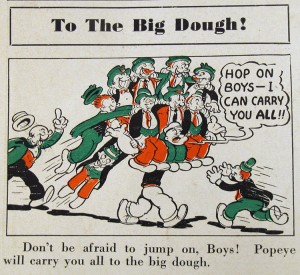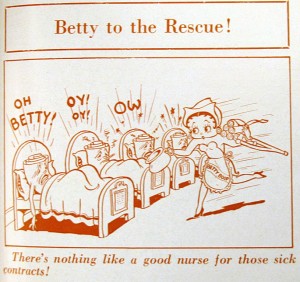Here we are at the #2 installment of the Paramount Sales News cartoons. Hal Seeger gives us one offering a week beginning at the end of March 1934. Excuse the quality of April 18, I’m especially sorry because it’s a beautiful example of “things come to creepy life” that epitomized the Fleischer studio style. Lots more of them to come.
I also should have addressed in my initial post that “in the red” means losing money in sales language and “green,” rather than “black,” means profit, but didn’t because I thought that was obvious. Evidently not, as some of the younger readers on Facebook thought “beat the red” meant Disney cartoons. Really!? What would clean-living Walt say?
(Please note: There was no cartoon in April 11’s edition)
March-April 1934

March 14, 1934
Here’s what the salesmen had to work with. A sample of two great Fleischer cartoons in release during the period these ads above were published.
Ha! Ha! Ha! (released March 2, 1934)
Can You Take It (released April 27th 1934)










 THAD KOMOROWSKI is a writer, journalist, film restorationist and author of the acclaimed (and recently revised) Sick Little Monkeys: The Unauthorized Ren & Stimpy Story. He blogs at
THAD KOMOROWSKI is a writer, journalist, film restorationist and author of the acclaimed (and recently revised) Sick Little Monkeys: The Unauthorized Ren & Stimpy Story. He blogs at 

























































You mean that everybody doesn’t know the meaning of “in the red” and “in the green” any more? You have made me feel so old!
Come to think of it, it has been a long time since I have heard 25¢ called “two bits”, or 50¢ called “four bits”. Is that slang used any more?
Here’s a real old-timer. The government started making 5¢ coins out of nickel in 1883. They were silver half-dimes before then. Who remembers what the old slang name for them was before the nickel? The late 19th-century Horatio Alger novels are a gold mine of now-forgotten slang.
indian heads?
I’ve got a half-dime in my pocket right now! I believe the slang term was “fish scales”.
I’d never heard the half dimes called “fish scales” and it turns out that was the Canadian term for their version of the silver five-cent piece. Me, I was always fond of the original spelling, “disme” and “half disme.”
Nope. An Indian head was a 1¢ piece, called an Indian-head penny, from 1859 to 1909. There were so many in circulation that one would occasionally still show up in change during my childhood in the late 1940s-early 1950s, usually so worn by then that they had no collector’s value.
During the 1860s and for the next two or three decades, a silver half-dime was a “sixpence” and a dime was a “shilling”, named after the common British low-value coins. I first came across this when I read Horatio Alger’s “Ragged Dick; or, Street Life in New York”, written in 1867, set in New York City about the adventures of a homeless bootblack orphan boy. A man buys a 2¢ newspaper from a street-corner newsboy, and pays with “a shilling” and is given change. Since I knew that British coins were not legal tender in America by the 1860s, I investigated further and learned that a dime’s slang name was a shilling back then, and the silver half-dime was commonly called a sixpence.
One of the first things that you see in “Ragged Dick” is that Dick and all his associates say “in course” instead of “of course”, although Dick (who is trying to improve himself despite his lack of education) learns about halfway through the novel that “in course” is considered gutter slang. He has to start saying “of course” if he wants to associate with educated people.
Did you know that the U.S. had paper currency down to 5¢ bills in the 1860s and 1870s? There is a lot of American history “trivia” that you won’t learn in school today.
The expression is “in the red” or “in the black.” referring to in debt or at a balance or profit.
Come to think of it, it has been a long time since I have heard 25¢ called “two bits”, or 50¢ called “four bits”. Is that slang used any more?
I certainly don’t recall anyone using that slang myself (would that make a buck, “Eight Bits”? I outta use that to confuse my pals!).
Fred,
nickels had indian heads on them from 1913 – 1938.
Yeah, but those were commonly called buffalo nickels, not Indian-head nickels.
Chris: yes, eight bits were a dollar, but I don’t think a dollar was ever called that. When the U.S. became a nation in 1789. the dollar of 100 cents (also 1,000 mills, but there was never a coin smaller than a half-cent, and the government stopped making copper half-cent coins in 1857) became official. But the U.S. didn’t have any coins until the first U.S. Mint went into operation in 1791. Since the public needed small change immediately, the government made the Spanish 8-reales coin used in Mexico legal tender. The 8-reales coin, a large silver coin also called “the Spanish dollar” because it was the same size as the Dutch daalder that was used in Nieuw Nederlands before its conquest in 1664 (and was the first coin in use by the English settlers, since the English government didn’t allow them to bring any coins from England), was also called the “piece of eight” because it was scored by eight rays and was intended to be cut into 8 bits with metal shears, to be used as small change throughout the Spanish colonies. Since America used the same coins until there were enough U.S. coins to go around, people used two bit pieces officially worth 12 1/2 ¢ each, or 25 ¢, for a quarter-dollar, and four bits for 50¢. I believe that the bits were common change until around the 1820s when American small change became widespread, which was coincidentally when all the Spanish colonies declared their independence and stopped using the Spanish 8-reales piece. The Spanish silver bit remained legal tender in the U.S. until sometime in the 1850s, by which time they had disappeared anyway. Most coin stores today sell “a genuine Spanish Piece of Eight like the pirates used”, or the triangular wedge-shaped bits, cheaply.
These are beautifully cartooned pieces. It’s great to be able to see them. I hope they inspired salesmen to sell these fine cartoons!
I see that the kids from “Strong to the Finich” are on one of those cards.